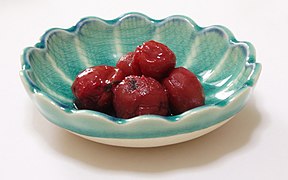Umeboshi
Umeboshi ( Japanese 梅干 し or 梅干 , or just in Hiragana う め ぼ し , from 梅 ume “plum” and - 干 し -boshi from the verb 干 す hosu “dry”, literally “plum-dried” or “prune”), also in German salt plums called, are in salt and red shiso leaves pickled Ume -Fruits. Although often referred to as plums, these fruits are more botanically related to apricots. Umeboshi are particularly popular in their country of origin, Japan . They are red to brownish in color, round and taste very salty and sour. The undried "salt plums" are called umezuke ( 梅 漬 け ), while the dried ones are called umeboshi ( 梅干 し ). There is also Karikari Ume ( カ リ カ リ 梅 or カ リ カ リ う め ; "crispy plum") made from unripe, green plums that are soaked in calcium and salt and not dried, with or without shiso.
In addition, smoked and dried salt plums are also produced, known as Ubai ( う ば い ), in Korea as Omae ( 오매 ), in China as "black plum" ( Chinese 烏梅 / 乌梅 , pinyin wūméi ; dark plum, smoked or black ume), other types can be found under Ume . In traditional Chinese medicine , they are used against parasites , ulcers, and to support the digestive system and heart.
Traditional production
The ume fruits, which are harvested green, are cleaned and layered together with salt in large wooden tubs. The salt content is between 12 and 25%. Soaking in salt leads to lactic acid fermentation , similar to the production of sauerkraut . The salt removes water from the fruits, a weighted, matching lid forces them to stay below the liquid level, and its weight also pushes water out of the fruits. At the same time, the desired lactic acid fermentation begins.
After one to two months of fermentation in the vats, the fruits are dried outdoors for four to seven days, depending on the weather. The fruits are now white, some of them are sold as shiroboshi . The remaining salt fruits are soaked with Shiso leaves in the umeboshi brew that is created during lactic acid fermentation. After about a week, the fruits are removed and stacked in barrels together with Shiso leaves, where they mature for another year or two.
During this time, the umeboshi take on their characteristic color from the shiso leaves, which are also purple. They are red and quite salty and sour, which is why they are only eaten in small portions. Umeboshi are often used as an accompaniment to rice in a bentō . The umeboshi are also made into a paste (bainiku) or roasted with the core on charcoal and ground into powder.
consumption
Umeboshi are usually not processed further before consumption. They are often served in onigiri , for example in bento boxes. The red fruit in the middle of the white rice is reminiscent of the Japanese flag ( Hinomaru bentō; from Hi no Maru , 'sun disk').
Medical use
Umeboshi have an antibacterial effect, especially for diarrhea and dysentery . They work better than z. B. bismuth subsalicylate . The salty and sour umeboshi also works very well for sore throats. It is also known as the Japanese Alka-Seltzer , with the difference that it has no side effects.
Umeboshi are usually with kudzu or Bancha administered -Tee together. The umeboshi powder has an even stronger effect.
Web links
Individual evidence
- ↑ Umeboshi: The traditional manufacturing process on eco4u.de, accessed on February 12, 2017.
- ^ Susan W. Kramer: The Naturally Healthy Traveler. 2nd edition, Lotus Press, 2012, ISBN 978-0-9409-8504-9 , p. 93.
- ^ Paul Pitchford: Healing with Whole Foods: Asian Traditions and Modern Nutrition. 3rd edition, North Atlantic Books, 2002, ISBN 978-1-55643-471-6 , p. 623.
- ^ Margot Skinner, Denise Hunter: Bioactives in Fruit: Health Benefits and Functional Foods. John Wiley & Sons, 2013, ISBN 978-1-118-63559-9 .





